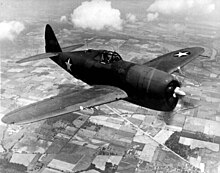Glenn E. Duncan
Glenn Emile Duncan | |
|---|---|
Stewart Air Force Base | |
| Battles/wars | World War II Korean War |
| Awards | Distinguished Service Cross Silver Star Distinguished Flying Cross (8) Air Medal (4) |
Glenn Emile Duncan (May 12, 1918 – July 4, 1998) was a career officer in the
Early life
Duncan was born on May 19, 1918, in Bering, Texas.
Military career
He enlisted in the Aviation Cadet Program of the
World War II
Duncan served as an instructor pilot for a year and then served in

In mid-1943, the 353rd FG was initially stationed at

Duncan became a flying ace, when he destroyed a Fw 190 over Rastede on December 20, his fifth aerial victory. During a bomber escort near Ans, Belgium on 20 January 1944, his flight encountered four twin-engined Messerschmitt Bf 110s. In the dogfight, he destroyed two Bf 110s. In April 1944, the 353rd FG moved to their new base in RAF Raydon.
By June 7, 1944, he had accumulated 15½ kills. On the 12th June, he shot down three Bf-109s. He claimed his 19th and last aerial victory on July 5, when he shot down a Bf 109 over Pont-Audemer.[3]
On July 7, 1944, while leading an aerial attack on an
He then evaded capture on foot and walked towards Netherlands. He joined the Dutch resistance, before being liberated by the Allied forces 10 months later, in April 1945.

Duncan then rejoined the 353rd Fighter Group as its commanding officer, which was now equipped with the
During World War II, Duncan was credited with destroying 19.5 enemy aircraft in the air, 1 probable kill, and 7 damaged. He was also credited with destroying 9 enemy aircraft on the ground while strafing enemy airfields.
During his time with the 353rd FG, he flew aircraft bearing the name "Dove of Peace", with code LH-X. There were P-47s and P-51 with this title in the 353rd Fighter Group at that time.
Post war
He then served as an instructor with the Air National Guard until June 1949, when he became a White House Liaison Officer. Duncan served at the White House and with Headquarters U.S. Air Force in the Pentagon until May 1953, when he was transferred to Japan to serve as Deputy Commander of the 39th Air Division at Misawa Air Base, from August 1953 to July 1956.
His next assignment was as Commander of the
He served as Base Commander of
Later life
Duncan died on July 14, 1998, and was buried at Arlington National Cemetery.
Awards and decorations
Glenn Duncan's ribbons, including retroactive awards:-[4]
| Distinguished Service Cross | |
| Silver Star | |
| Distinguished Flying Cross with one silver and two bronze oak leaf clusters | |
| Air Medal with three bronze oak leaf clusters | |
| Air Force Commendation Medal with bronze oak leaf cluster | |
| Army Commendation Medal | |
Air Force Outstanding Unit Award
| |
| American Defense Service Medal | |
| American Campaign Medal | |
campaign stars
| |
| World War II Victory Medal | |
| Army of Occupation Medal | |
| National Defense Service Medal with one bronze service star | |
| Korean Service Medal | |
| Korea Defense Service Medal | |
Air Force Longevity Service Award with silver and bronze oak leaf cluster
| |
Small Arms Expert Marksmanship Ribbon
| |
| Distinguished Flying Cross (United Kingdom) | |
Croix de Guerre with Palm (France)
| |
Croix de Guerre with Palm (Belgium)
| |
United Nations Service Medal for Korea
| |
| Korean War Service Medal |
Distinguished Service Cross citation
- Duncan, Glenn E.
- Lieutenant Colonel (then Major), U.S Army Air Forces
- 353rd Fighter Group, 8th Air Force
- Date of Action: November 11, 1943
- Headquarters, European Theater of Operations, U.S. Army, General Orders No. 2 (January 10, 1944)
Citation:
The President of the United States of America, authorized by Act of Congress, July 9, 1918, takes pleasure in presenting the Distinguished Service Cross to Lieutenant Colonel (Air Corps), [then Major] Glenn Emile Duncan, United States Army Air Forces, for extraordinary heroism in connection with military operations against an armed enemy while serving as Pilot of a P-47 Fighter Airplane in the 353d Fighter Group, EIGHTH Air Force, in aerial combat against enemy forces over enemy-occupied Europe while leading a group of fighter aircraft on 11 November 1943. As a result of leading a squadron of his group against a large number of enemy aircraft, Lieutenant Colonel Duncan became separated from his group. He observed enemy aircraft attacking bombers and, though at an unfavorable altitude and in the face of overwhelming odds, Lieutenant Colonel Duncan vigorously attacked the enemy aircraft, destroying one and dispersing the remainder. While proceeding to his home base, he observed four enemy aircraft attacking a straggling Fortress. Although his gas supply was dangerously low, he engaged the enemy and dispersed them, thereby saving the Fortress and its crew. The action of Lieutenant Colonel Duncan reflect the highest credit upon himself and the armed forces of the United States.[5]
References
- ISBN 978-1-61060-702-5.
- ISBN 978-1-78200-889-7.
- ^ a b c d e "Glenn E. Duncan". Acepilots.com. Archived from the original on 2017-06-30. Retrieved 2018-05-13.
- ^ a b c "Veteran Tributes". veterantributes.org. Archived from the original on 2016-07-10. Retrieved 2016-12-31.
- ^ "Valor awards for Glenn Emile Duncan". valor.militarytimes.com. Archived from the original on 2016-12-26. Retrieved 2016-12-31.
